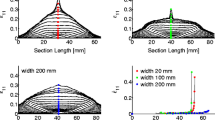Abstract
The kinetic equations of creep are used to compare damage accumulation in rods under tension in two forming modes: at constant stresses and at constant strain rates corresponding to strain rates in steady-state creep for the same stresses. It is found that from the point of view of increasing the residual service life at the production stage, forming to the required strain value with specified kinematics is preferable to forming at constant stresses for materials on whose strain-time diagrams for σ = const, the fracture strain decreases monotonically with increasing stress. Forming at constant stresses is preferable for materials on whose strain-time diagrams for σ = const, the fracture strain increases monotonically with increasing stress. Calculation results for several alloys are presented.
Similar content being viewed by others
References
I. A. Banshchikova, and I. Yu. Tsvelodub, “On One Class of Inverse Problems of Variation in Shape of Viscoelastic Plates,” Prikl. Mekh. Tekh. Fiz. 37 (6), 122–131 (1996) [J. Appl. Mech. Phys. 37 (6), 876–883 (1996)].
I. A. Banshchikova, and I. V. Sukhorukov, “Two-Dimensional Problems of Torsion and Bending of Profiles under Creep,” Vychisl. Tekhnol.-Region. Vest. Vostoka (joint edition) 8 (3), 104–110 (2003).
I. Yu. Tsvelodub, The Stability Postulate and Its Applications in Creep Theory of Metals (Lavrentyev Inst. of Hydrodynamics, Siberian Branch, USSR Acad. of Sci., Novosibirsk, 1991) [in Russian].
K. S. Bormotin, and A. Vin, “A Method of Dynamic Programming in the Problems of Optimal Panel Deformation in the Creep Mode,” Vychisl. Met. Programm. 19 (4), 470–478 (2018).
K. S. Bormotin, “Inverse Problems of Optimal Control in Creep Theory,” Sib. Zh. Indust. Mat. 15 (2), 33–42 (2012).
K. S. Bormotin, and A. I. Oleinikov, “Variational Principles and Optimal Solutions of the Inverse Problems of Creep Bending of Plates,” Prikl. Mekh. Tekh. Fiz. 53 (5), 136–46 (2012) [J. Appl. Mech. Phys. 53 (5), 751–760 (2012)].
O. V. Sosnin, B. V. Gorev, and A. F. Nikitenko, Energy Version of Creep Theory (Institute of Hydrodynamics, Siberian Branch, USSR Acad. of Sci, Novosibirsk, 1986) [in Russian].
B. V. Gorev, I. V. Lyubashevskaya, V. A. Panamarev, and S. V. Iyavoyenen, “Description of Creep and Fracture Process of Modern Construction Materials using Kinetic Equations in Energy Form,” Prikl. Mekh. Tekh. Fiz. 55 (6), 132–144 (2014) [J. Appl. Mech. Phys. 55 (6), 1020–1030 (2014)].
B. V. Gorev, and I. D. Klopotov, “Description of the Creep Process and Long Strength by Equations with One Scalar Damage Parameter,” Prikl. Mekh. Tekh. Fiz. 35 (5), 92–102 (1994) [J. Appl. Mech. Phys. 35 (5), 726–734 (1994)].
B. V. Gorev, and I. A. Banshchikova, “Description of the Creep and Fracture of Hardened Materials According to Kinetic Equations with a Scalar Damage Parameter,” Vestn. Samar. Gos. Tekh. Univ., Ser. Fiz.-Mat. Nauki, No. 2, 90–98 (2009).
B. V. Gorev, and I. A. Banshchikova, “Description of the Falling Section of the Strain-Strain Curve using Kinetic Equations with a Scalar Damage Parameter,” Vestn. Samar. Gos. Tekh. Univ., Ser. Fiz.-Mat. Nauki, No. 2, 110–117 (2008).
S. V. Iyavoynen, I. A. Banshchikova, I. V. Lubashevskaya, M. A. Legan, “High Temperature Creep of Steel 09G2S under Non-Stationary Loading,” J. Phys.: Conf. Ser. 894. 012123 (2017); DOI: https://doi.org/10.1088/1742-6596/894/1/012123.
O. V. Sosnin, A. F. Nikitenko, and B. V. Gorev, “Justification of the Energy Variant of the Theory of Creep and Long-Term Strength of Metals,” Prikl. Mekh. Tekh. Fiz. 51 (4), 188–197 (2010) [J. Appl. Mech. Phys. 51 (4), 608–614. (2010)].
N. A. Veklich, A. M. Lokoshchenko, and P. N. Veklich, “Modeling the Deformability of a Material,” Prikl. Mekh. Tekh. Fiz. 48 (5), 183–188 (2007) [J. Appl. Mech. Phys. 48 (5), 774–778 (2007)].
A. M. Lokoshchenko, and S. A. Shesterikov, “Creep Strength Model with Nonmonotonic Dependence of the Strain during Rupture on the Stress,” Prikl. Mekh. Tekh. Fiz., No. 1, 160–163 (1982) [J. Appl. Mech. Phys. No. 1, 151–153 (1982)].
I. A. Banshchikova, B. V. Gorev, and M. A. Legan, “Laws of the Creep of Metallic Materials at high Temperatures,” J. Phys.: Conf. Ser. 754, 082001 (2016); DOI: https://doi.org/10.1088/1742-6596/754/8/082001.
B. V. Gorev, and I. A. Banshchikova, “On Rational Deformation Modes of Metal Materials under Creep,” in Safety and Monitoring of Technogenic and Natural Systems: Proc. 6th All-Russian Conf., Krasnoyarsk, September 18–21, 2018 (Sib. Feder. Univ., Krasnoyarsk, 2018), pp. 165–170.
A. M. Lokoshchenko, Creep and Long-Term Strength of Metals (Fizmatlit, Moscow, 2016; CRC Press-Taylor and Francis Group, Boca Raton-London-New York); https://doi.org/10.1201/b22242.
C. M. Stewart, A. P. Gordon, Y. W. Ma, R. W. Neu, “An Anisotropic Tertiary Creep Damage Constitutive Model for Anisotropic Materials,” Int. J. Pressure Vessels Piping. 88, 356–364 (2011); DOI: https://doi.org/10.1016/j.ijpvp.2011.06.010.
Author information
Authors and Affiliations
Corresponding author
Additional information
Original Russian Text © I.A. Banshchikova.
__________
Translated from Prikladnaya Mekhanika i Tekhnicheskaya Fizika, Vol. 60, No. 6, pp. 139–148, November-December, 2019.
Rights and permissions
About this article
Cite this article
Banshchikova, I.A. On the Choice of Forming Modes and Estimation of Residual Service Life Using Kinetic Equations with a Scalar Damage Parameter. J Appl Mech Tech Phy 60, 1096–1103 (2019). https://doi.org/10.1134/S0021894419060154
Received:
Revised:
Accepted:
Published:
Issue Date:
DOI: https://doi.org/10.1134/S0021894419060154




